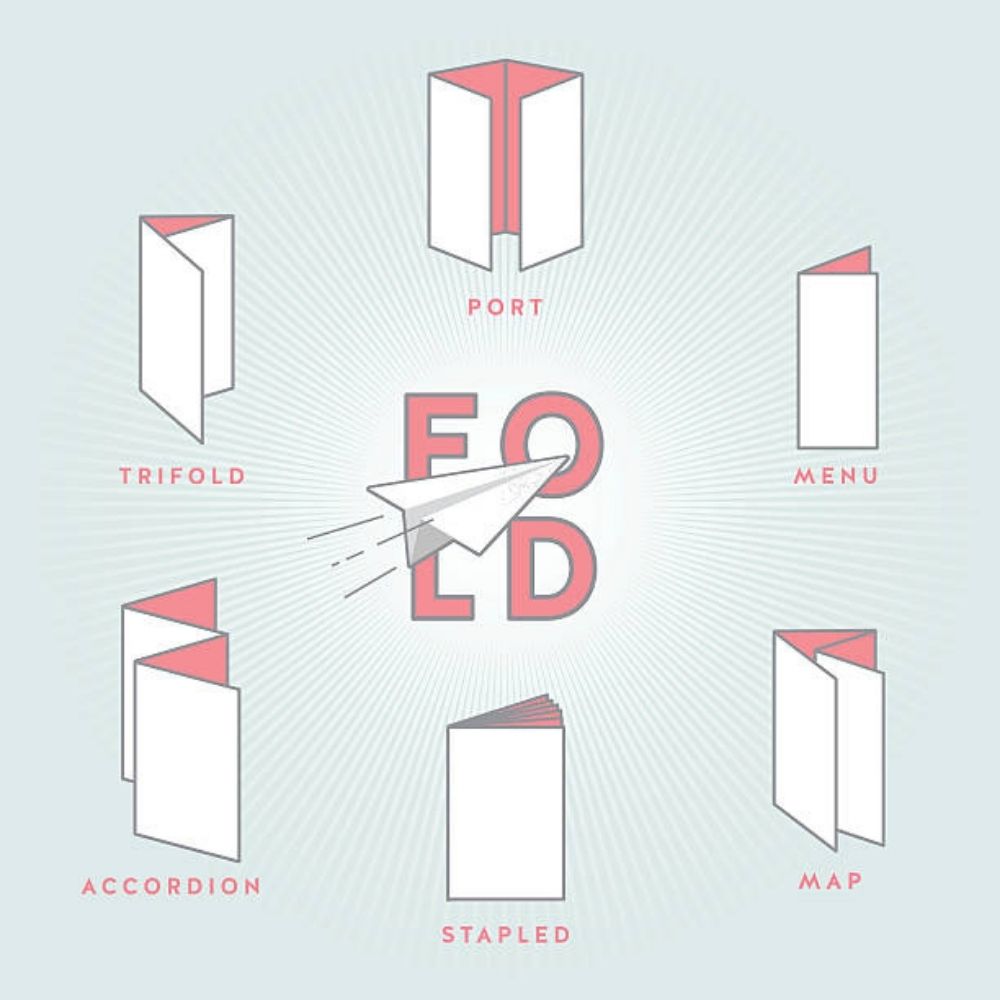For your print marketing, we’ve compiled a guide to the most popular types of brochure folds. Make sure your call to action is compelling and ensure maximum ROI. So, let’s discuss the different styles of brochures? Let’s take a look.
You Should Try These 6 Brochure Folds Right Now
1. The Half Fold
Half-fold brochures are also known as bi-fold brochures. A paper whose edges are folded over, creating the appearance of a booklet. The reader is presented with two main internal panels when the brochure is opened. The rear cover is a great place to introduce a story idea since it can introduce a concept. Inside the fold, provide more relevant information before giving a call-to-action or a final message.
Due to that, it’s a perfect medium to tell your startup story or introduce your brand new product. This is a great chance to showcase two of the key messages about your product or event. This template has plenty of space for images, graphics, and bold text. Generally speaking, this is an optimal brochure for large amounts of information because it’s a fail-safe, introductory brochure.
2. The Tri-Fold
A trifold brochure divides an A4 sheet into three rectangular sections. On top of the central panel, the left and right panels are typically folded over, with the right panel on top. There is less space for content on each of the slimmer panels in this structure, so an inventive design will be needed to avoid the panels feeling cluttered or confusing. Even so, the slightly more complicated fold gives you endless opportunities to design fantastic sections and engage your audience.
In addition, this brochure folds into a travel-friendly size that makes it less likely to be thrown away by your audience! Instead of asking a question on the front panel and responding once both left and right panels have been opened, why not ask one on the front panel? Consider using each forum to highlight a different aspect of your brand or product? Organizing your brochure in this manner will help you digest it more easily. Be creative when it comes to the paper you use.
3. The Gate Fold
When used well, the gatefold can be a highly impactful way to convey a specific message or accomplish a particular marketing goal. A fold is created by dividing the page into one large panel, then two smaller panels. Each forum is half the size of the giant board. They then fold inward, forming a gate-like appearance unlike different styles of brochures.
Typically, since these brochures are slightly more expensive, they’re used to target high-end audiences regarding niche products, events, or brands. Despite this, it may appear to be a more expensive brochure, and therefore more likely to be kept and viewed again by potential clients. A sizeable inner panel is perfect for the design of visual-heavy graphics, which are enhanced by the gatefold’s reveal effect.
4. The Cross Fold
Cross folds also work well because they fold the paper multiple times, resulting in a small size after folding. Taking larger-than-life designs and cutting them down to a manageable size works well in this context. This is why transportation maps and tourism guides often use this fold. Typically, they contain a ‘front cover’ that indicates what will be inside the folded paper. This allows the reader to transport a larger sheet of paper with them.
When designing your brochure, you can include plenty of images, diagrams, or a map on this large surface area. Blank space can be utilized in either case. Make your design pop on such a large surface area. When opened out, your flyer might be repurposed as a custom poster. Your brand would thereby receive lasting and meaningful exposure if you choose this design for your brochure, so if you are selecting the cross fold, be sure to design it in a more poster-like and visually appealing way.
5. The Z Fold
Another popular brochure fold is the z fold. The three panels are double-sided, just like in the tri-fold. Rather than fold inwards, the way this is folded is similar to what an accordion would be. Z folds offer the advantage of dividing content into three sections or arranging it across three panels to take advantage of more space.
A page can contain information from one to another. In this way, you can use suspense to reveal a sentence that begins on one panel and is completed on the next.
6. The Die-Cut Fold
You can make your product or brand stand out by creating a die-cut fold that impacts potential customers. As with the z-fold brochure, the front panel is smaller than the other two due to a diagonal cut at the top of the paper. If the brochure is folded shut, the two other panels are visible on the front.
The die-cut fold is an excellent opportunity to add visual humor since the back panels can be seen through the fold, providing an extra dimension to the front panel. This effect is always very striking; unlike different styles of brochures.
